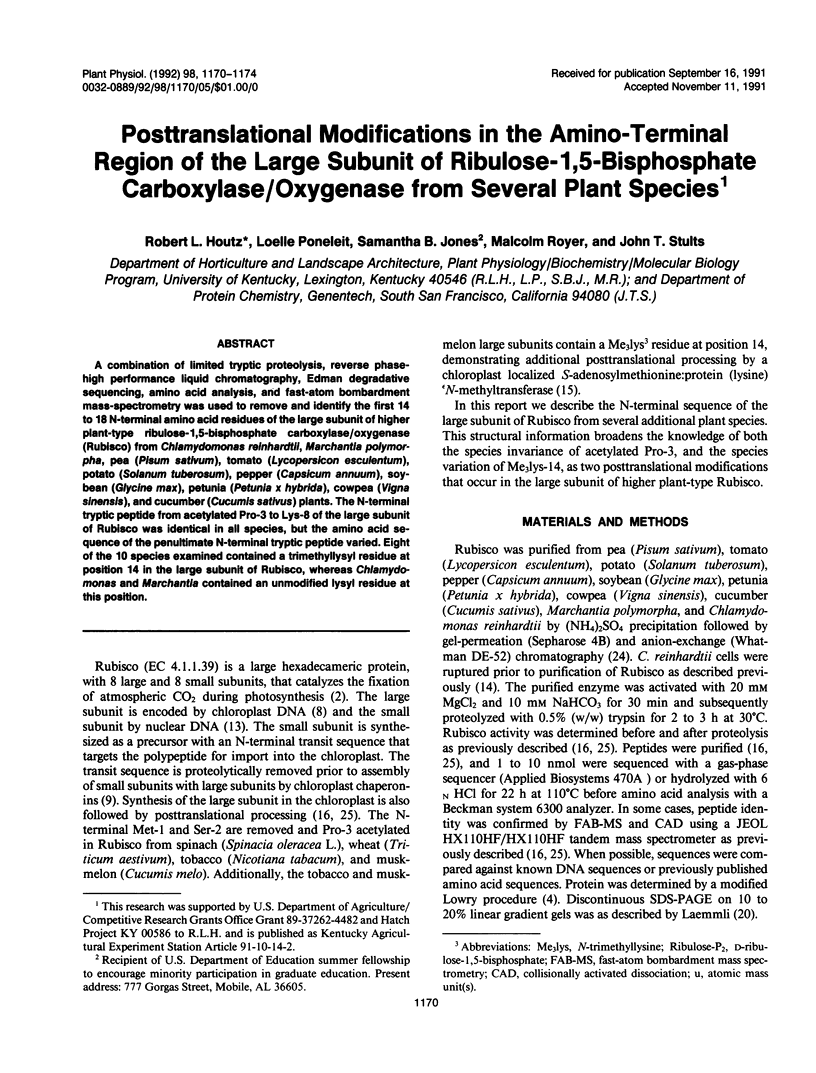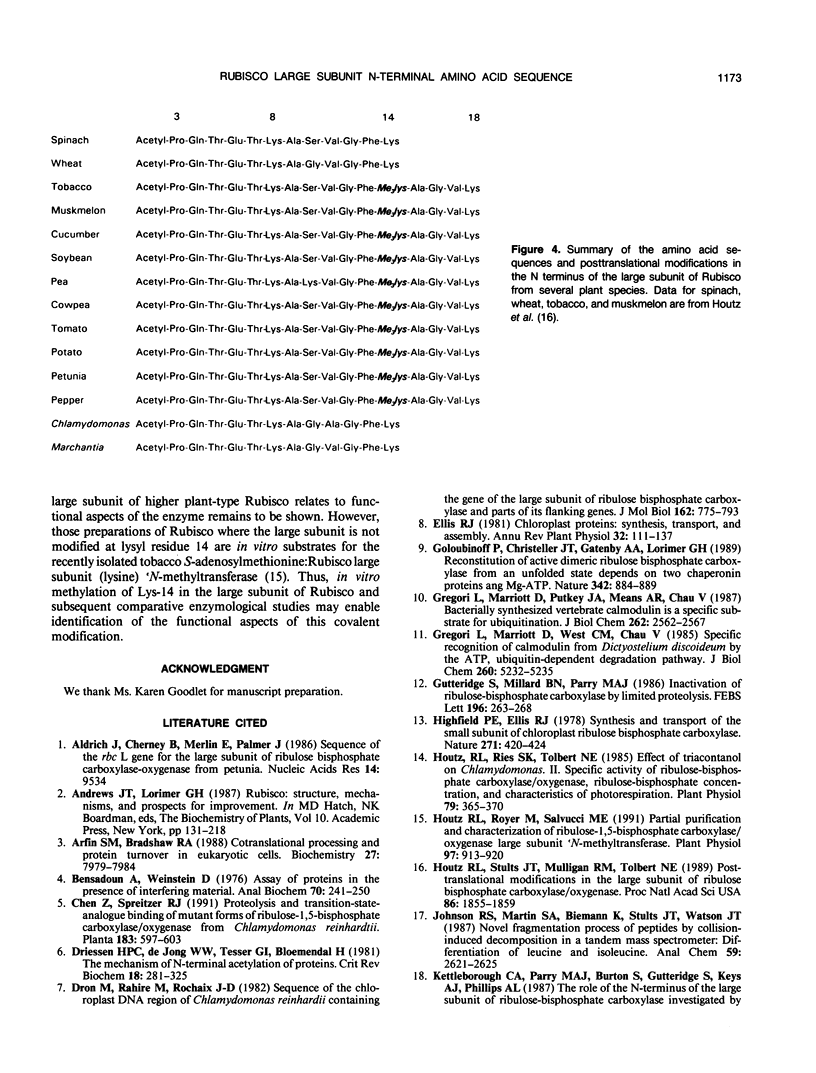Abstract
A combination of limited tryptic proteolysis, reverse phasehigh performance liquid chromatography, Edman degradative sequencing, amino acid analysis, and fast-atom bombardment mass-spectrometry was used to remove and identify the first 14 to 18 N-terminal amino acid residues of the large subunit of higher plant-type ribulose-1,5-bisphosphate carboxylase/oxygenase (Rubisco) from Chlamydomonas reinhardtii, Marchantia polymorpha, pea (Pisum sativum), tomato (Lycopersicon esculentum), potato (Solanum tuberosum), pepper (Capsicum annuum), soybean (Glycine max), petunia (Petunia x hybrida), cowpea (Vigna sinensis), and cucumber (Cucumis sativus) plants. The N-terminal tryptic peptide from acetylated Pro-3 to Lys-8 of the large subunit of Rubisco was identical in all species, but the amino acid sequence of the penultimate N-terminal tryptic peptide varied. Eight of the 10 species examined contained a trimethyllysyl residue at position 14 in the large subunit of Rubisco, whereas Chlamydomonas and Marchantia contained an unmodified lysyl residue at this position.
Full text
PDF




Images in this article
Selected References
These references are in PubMed. This may not be the complete list of references from this article.
- Aldrich J., Cherney B., Merlin E., Palmer J. Sequence of the rbcL gene for the large subunit of ribulose bisphosphate carboxylase-oxygenase from petunia. Nucleic Acids Res. 1986 Dec 9;14(23):9534–9534. doi: 10.1093/nar/14.23.9534. [DOI] [PMC free article] [PubMed] [Google Scholar]
- Arfin S. M., Bradshaw R. A. Cotranslational processing and protein turnover in eukaryotic cells. Biochemistry. 1988 Oct 18;27(21):7979–7984. doi: 10.1021/bi00421a001. [DOI] [PubMed] [Google Scholar]
- Bensadoun A., Weinstein D. Assay of proteins in the presence of interfering materials. Anal Biochem. 1976 Jan;70(1):241–250. doi: 10.1016/s0003-2697(76)80064-4. [DOI] [PubMed] [Google Scholar]
- Driessen H. P., de Jong W. W., Tesser G. I., Bloemendal H. The mechanism of N-terminal acetylation of proteins. CRC Crit Rev Biochem. 1985;18(4):281–325. doi: 10.3109/10409238509086784. [DOI] [PubMed] [Google Scholar]
- Dron M., Rahire M., Rochaix J. D. Sequence of the chloroplast DNA region of Chlamydomonas reinhardii containing the gene of the large subunit of ribulose bisphosphate carboxylase and parts of its flanking genes. J Mol Biol. 1982 Dec 25;162(4):775–793. doi: 10.1016/0022-2836(82)90547-2. [DOI] [PubMed] [Google Scholar]
- Goloubinoff P., Christeller J. T., Gatenby A. A., Lorimer G. H. Reconstitution of active dimeric ribulose bisphosphate carboxylase from an unfoleded state depends on two chaperonin proteins and Mg-ATP. Nature. 1989 Dec 21;342(6252):884–889. doi: 10.1038/342884a0. [DOI] [PubMed] [Google Scholar]
- Gregori L., Marriott D., Putkey J. A., Means A. R., Chau V. Bacterially synthesized vertebrate calmodulin is a specific substrate for ubiquitination. J Biol Chem. 1987 Feb 25;262(6):2562–2567. [PubMed] [Google Scholar]
- Gregori L., Marriott D., West C. M., Chau V. Specific recognition of calmodulin from Dictyostelium discoideum by the ATP, ubiquitin-dependent degradative pathway. J Biol Chem. 1985 May 10;260(9):5232–5235. [PubMed] [Google Scholar]
- Houtz R. L., Ries S. K., Tolbert N. E. Effect of Triacontanol on Chlamydomonas: II. Specific Activity of Ribulose-Bisphosphate Carboxylase/Oxygenase, Ribulose-Bisphosphate Concentration, and Characteristics of Photorespiration. Plant Physiol. 1985 Oct;79(2):365–370. doi: 10.1104/pp.79.2.365. [DOI] [PMC free article] [PubMed] [Google Scholar]
- Houtz R. L., Royer M., Salvucci M. E. Partial Purification and Characterization of Ribulose-1,5-bisphosphate Carboxylase/Oxygenase Large Subunit epsilonN-Methyltransferase. Plant Physiol. 1991 Nov;97(3):913–920. doi: 10.1104/pp.97.3.913. [DOI] [PMC free article] [PubMed] [Google Scholar]
- Houtz R. L., Stults J. T., Mulligan R. M., Tolbert N. E. Post-translational modifications in the large subunit of ribulose bisphosphate carboxylase/oxygenase. Proc Natl Acad Sci U S A. 1989 Mar;86(6):1855–1859. doi: 10.1073/pnas.86.6.1855. [DOI] [PMC free article] [PubMed] [Google Scholar]
- Johnson R. S., Martin S. A., Biemann K., Stults J. T., Watson J. T. Novel fragmentation process of peptides by collision-induced decomposition in a tandem mass spectrometer: differentiation of leucine and isoleucine. Anal Chem. 1987 Nov 1;59(21):2621–2625. doi: 10.1021/ac00148a019. [DOI] [PubMed] [Google Scholar]
- Klee C. B., Vanaman T. C. Calmodulin. Adv Protein Chem. 1982;35:213–321. doi: 10.1016/s0065-3233(08)60470-2. [DOI] [PubMed] [Google Scholar]
- Laemmli U. K. Cleavage of structural proteins during the assembly of the head of bacteriophage T4. Nature. 1970 Aug 15;227(5259):680–685. doi: 10.1038/227680a0. [DOI] [PubMed] [Google Scholar]
- Liu X. Q., Jagendorf A. T. Neutral peptidases in the stroma of pea chloroplasts. Plant Physiol. 1986 Jun;81(2):603–608. doi: 10.1104/pp.81.2.603. [DOI] [PMC free article] [PubMed] [Google Scholar]
- Lukas T. J., Wiggins M. E., Watterson D. M. Amino Acid sequence of a novel calmodulin from the unicellular alga chlamydomonas. Plant Physiol. 1985 Jul;78(3):477–483. doi: 10.1104/pp.78.3.477. [DOI] [PMC free article] [PubMed] [Google Scholar]
- Marshak D. R., Clarke M., Roberts D. M., Watterson D. M. Structural and functional properties of calmodulin from the eukaryotic microorganism Dictyostelium discoideum. Biochemistry. 1984 Jun 19;23(13):2891–2899. doi: 10.1021/bi00308a007. [DOI] [PubMed] [Google Scholar]
- McCurry S. D., Gee R., Tolbert N. E. Ribulose-1,5-bisphosphate carboxylase/oxygenase from spinach, tomato, or tobacco leaves. Methods Enzymol. 1982;90(Pt E):515–521. doi: 10.1016/s0076-6879(82)90178-1. [DOI] [PubMed] [Google Scholar]
- Mulligan R. M., Houtz R. L., Tolbert N. E. Reaction-intermediate analogue binding by ribulose bisphosphate carboxylase/oxygenase causes specific changes in proteolytic sensitivity: the amino-terminal residue of the large subunit is acetylated proline. Proc Natl Acad Sci U S A. 1988 Mar;85(5):1513–1517. doi: 10.1073/pnas.85.5.1513. [DOI] [PMC free article] [PubMed] [Google Scholar]
- Paik W. K., Kim S. Protein methylation: chemical, enzymological, and biological significance. Adv Enzymol Relat Areas Mol Biol. 1975;42:227–286. doi: 10.1002/9780470122877.ch5. [DOI] [PubMed] [Google Scholar]
- Roberts D. M., Rowe P. M., Siegel F. L., Lukas T. J., Watterson D. M. Trimethyllysine and protein function. Effect of methylation and mutagenesis of lysine 115 of calmodulin on NAD kinase activation. J Biol Chem. 1986 Feb 5;261(4):1491–1494. [PubMed] [Google Scholar]
- Rowe P. M., Wright L. S., Siegel F. L. Calmodulin N-methyltransferase. Partial purification and characterization. J Biol Chem. 1986 May 25;261(15):7060–7069. [PubMed] [Google Scholar]
- Smyth D. G., Massey D. E., Zakarian S., Finnie M. D. Endorphins are stored in biologically active and inactive forms: isolation of alpha-N-acetyl peptides. Nature. 1979 May 17;279(5710):252–254. doi: 10.1038/279252a0. [DOI] [PubMed] [Google Scholar]
- WALLER J. P., DIXON H. B. Selective acetylation of the terminal amino group of corticotrophin. Biochem J. 1960 May;75:320–328. doi: 10.1042/bj0750320. [DOI] [PMC free article] [PubMed] [Google Scholar]
- Wettern M., Parag H. A., Pollmann L., Ohad I., Kulka R. G. Ubiquitin in Chlamydomonas reinhardii. Distribution in the cell and effect of heat shock and photoinhibition on its conjugate pattern. Eur J Biochem. 1990 Aug 17;191(3):571–576. doi: 10.1111/j.1432-1033.1990.tb19159.x. [DOI] [PubMed] [Google Scholar]
- Zurawski G., Whitfeld P. R., Bottomley W. Sequence of the gene for the large subunit of ribulose 1,5-bisphosphate carboxylase from pea chloroplasts. Nucleic Acids Res. 1986 May 12;14(9):3975–3975. doi: 10.1093/nar/14.9.3975. [DOI] [PMC free article] [PubMed] [Google Scholar]



